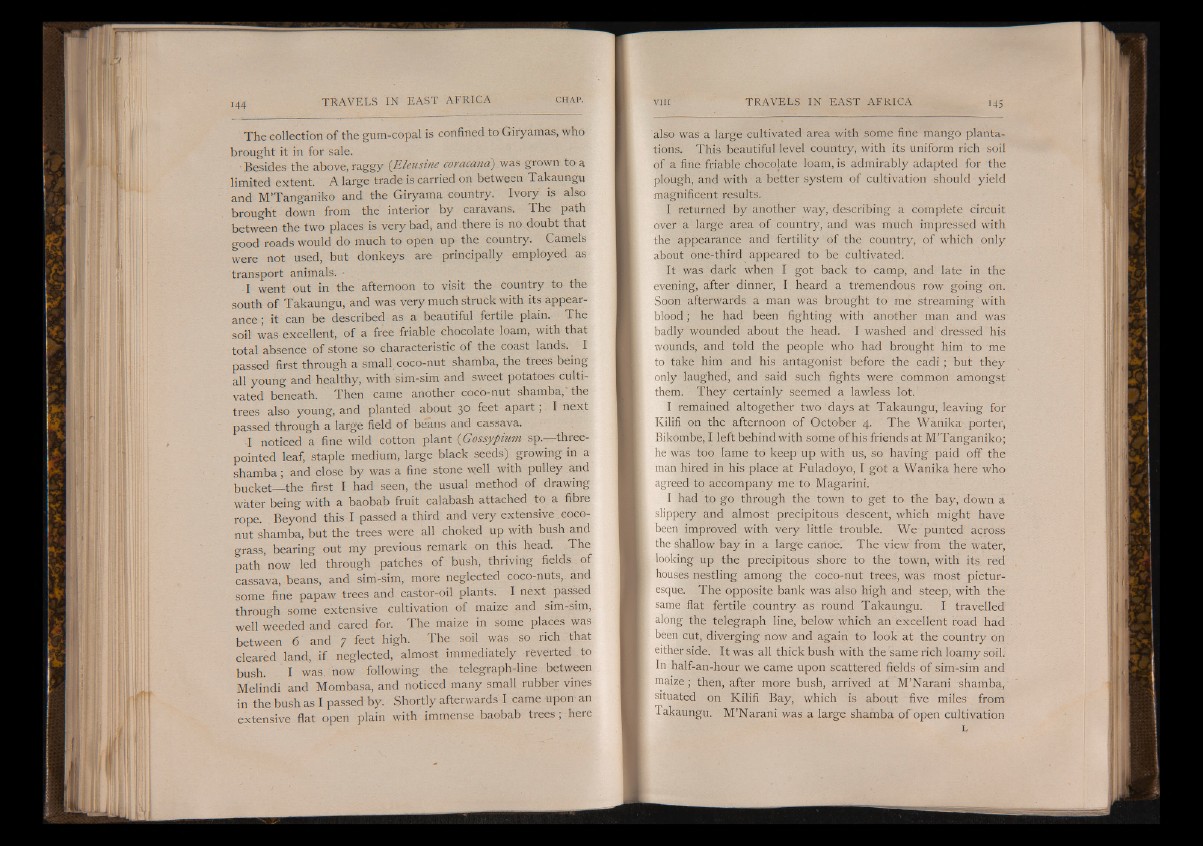
The collection of the gum-copal is confined to Giryamas, who
brought it in for sale.
Besides the above, raggy (Eleusine coracana) was grown to a
limited extent. A large trade is carried on between Takaungu
and M’Tanganiko and the Giryama country. Ivory is also
brought down from the interior by caravans. The path
between the two places is very bad* and there is no doubt that
good roads would do much to open up the country. Camels
were not used, but donkeys are principally employed as
transport animals. •
I went out in the afternoon to visit the country to the
south of Takaungu, and was very much struck with its appearance
; it can be described as a beautiful fertile plain. The
soil was* excellent, of a free friable chocolate loam, with that
total absence of stone so characteristic of the coast lands. I
passed first through a small, coco-nut shamba, the trees being
all young and healthy, with sim-sim and sweet potatoes cultivated
beneath. Then came another coco-nut shamba, the
trees also young; and planted about 3° fee^ apart, I next
passed through a large field of beans and cassava.
I noticed a fine wild cotton plant {Gossypiitm sp.—-three-
pointed leaf, staple medium, large black seeds) growing in a
shamba; and close by was a fine stone well with pulley a.nd
bucket— the first I had seen, the usual method of drawing
water being with a baobab fruit calabash attached to a fibre
rope. Beyond this I passed a third and very extensive coconut
shamba, but the trees were all choked up with bush and
grass, bearing out my previous remark on this head. The
path’now led through patches of bush, thriving fields of
cassava, beans, and sini-sim, more neglected coco-nuts,, and
some fine papaw trees and castor-oil plants. I next passed
through some extensive cultivation of maize and sim-sim,
well weeded and cared for. The maize in some places was
between 6 and 7 feet high. The soil was so rich that
cleared land, if neglected, almost immediately reverted to
bush. I was. now following the telegraph-line between
Melindi and Mombasa, and noticed many small rubber vines
in the bush as I passed by. Shortly afterwards I came upon an
extensive flat open plain with immense baobab trees; here
also was a large cultivated area with some fine mango plantations.
This beautiful level country, with its uniform rich soil
of a fine friable chocolate loam, is admirably adapted for the
plough, and with a better system of cultivation should yield
magnificent results.
I returned by another way, describing a complete circuit
over a large area of country, and was much impressed with
the appearance and fertility of the country, of which only
about one-third appeared to be cultivated.
It was dark when I got back to camp, and late in the
evening, after dinner, I. heard a tremendous row going on.
Soon afterwards a man was brought to me streaming' with
blood; he had been fighting with another man and was
badly wounded about the head. I washed and dressed his
wounds, and told the people who had brought him to me
to take him and his antagonist before the cadi; but they
only laughed, and said such fights were common amongst
them. They certainly seemed a lawless lot.
I remained altogether two days at Takaungu, leaving for
Kilifi on the afternoon of October 4. The Wanika porter,
Bikombe, I left behind with some of his friends at M’Tanganiko;
he was too lame to keep up with us, so having paid off the
man hired in his place at Fuladoyo, I got a Wanika here who
agreed to accompany me to Magarini.
I had to go through the town to get to the bay, down a
slippery and almost precipitous descent, which might have
been improved with very little trouble. We punted across
the shallow bay in a large canoe. The view from the water,
looking up the precipitous shore to the town, with its. red
houses nestling among the coco-nut trees, was most picturesque.
The opposite bank was also high and steep, with the
same flat fertile country as round Takaungu. I travelled
along the telegraph line, below which an excellent road had
been cut, diverging now and again to look at the country on
either side. It was all thick bush with the same rich loamy soil.
In half-an-hour we came upon scattered fields of sim-sim and
maize; then, after more bush, arrived at M’Narani shamba,
situated on Kilifi Bay, which is about five miles from
Takaungu. M’Narani was a large shamba of open cultivation
L